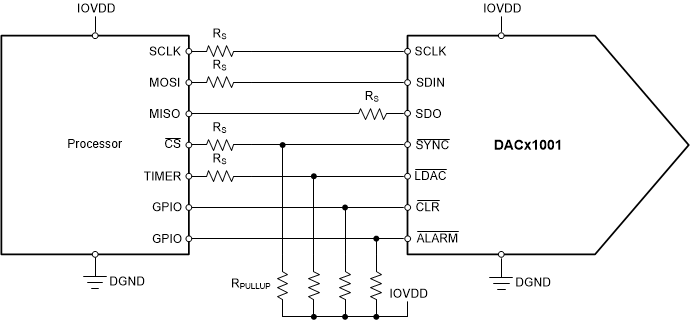ZHCSKD4A October 2019 – December 2019 DAC11001A , DAC81001 , DAC91001
UNLESS OTHERWISE NOTED, this document contains PRODUCTION DATA.
- 1 特性
- 2 应用
- 3 说明
- 4 修订历史记录
- 5 Device Comparison Table
- 6 Pin Configuration and Functions
-
7 Specifications
- 7.1 Absolute Maximum Ratings
- 7.2 ESD Ratings
- 7.3 Recommended Operating Conditions
- 7.4 Thermal Information Package
- 7.5 Electrical Characteristics
- Table 1. Timing Requirements: Write, 4.5 V ≤ DVDD ≤ 5.5 V
- Table 2. Timing Requirements: Write, 2.7 V ≤ DVDD < 4.5 V
- Table 3. Timing Requirements: Read and Daisy-Chain Write, 4.5 V ≤ DVDD ≤ 5.5 V
- Table 4. Timing Requirements: Read and Daisy-Chain Write, 2.7 V ≤ DVDD < 4.5 V
- 7.6 Typical Characteristics
-
8 Detailed Description
- 8.1 Overview
- 8.2 Functional Block Diagram
- 8.3 Feature Description
- 8.4 Device Functional Modes
- 8.5 Programming
- 8.6
Register Map
- 8.6.1 NOP Register (address = 00h) [reset = 0x000000h]
- 8.6.2 DAC-DATA Register (address = 01h) [reset = 0x000000h]
- 8.6.3 CONFIG1 Register (address = 02h) [reset = 004C80h for bits [23:0]]
- 8.6.4 DAC-CLEAR-DATA Register (address = 03h) [reset = 000000h for bits [23:0]]
- 8.6.5 TRIGGER Register (address = 04h) [reset = 000000h for bits [23:0]]
- 8.6.6 STATUS Register (address = 05h) [reset = 000000h for bits [23:0]]
- 8.6.7 CONFIG2 Register (address = 06h) [reset = 000040h for bits [23:0]]
- 9 Application and Implementation
- 10Power Supply Recommendations
- 11Layout
- 12器件和文档支持
- 13机械、封装和可订购信息
9.3.1 Interfacing to a Processor
The DACx1001 family of DACs works with a 4-wire SPI interface. The digital interface of the DACx1001 to a processor is shown in Figure 67. The DACx1001 has an LDAC input option for synchronous output update. In ac-signal generation applications, the jitter in the LDAC signal contributes to signal-to-noise ratio (SNR). Therefore, the LDAC signal must be generated from a low-jitter timer in the processor. The CLR and ALARM pins are static signals, and therefore can be connected to general-purpose input-output (GPIO) pins on the processor. All active-low signals (SYNC, LDAC, CLR, and ALARM) must be pulled up to IOVDD using 10-kΩ resistors. ALARM is an output pin from the DAC, so the corresponding GPIO on the processor must be configured as an input. Either poll the GPIO, or configured the GPIO as an interrupt to detect any failure alarm from the DAC. When using a high SCLK frequency, use source termination resistors, as shown in Interfacing to a Processor. Typically, 33-Ω resistors work on printed circuit boards (PCBs) with a 50-Ω trace impedance.
 Figure 67. Interfacing to a Processor
Figure 67. Interfacing to a Processor